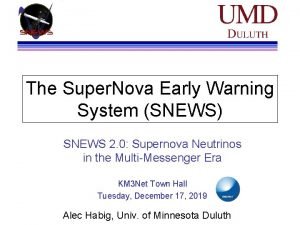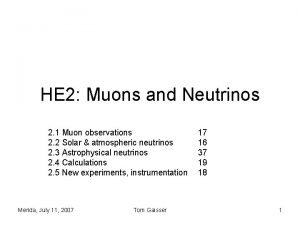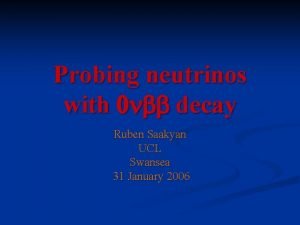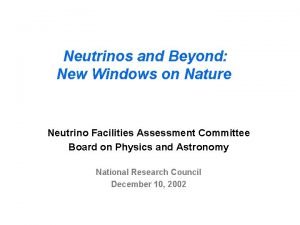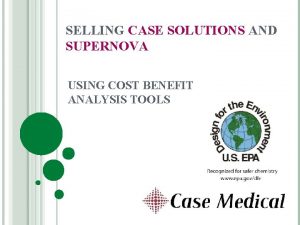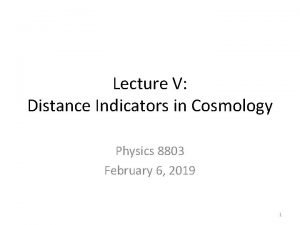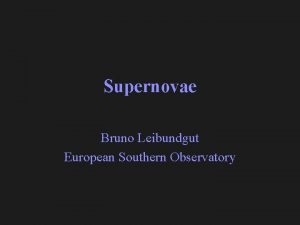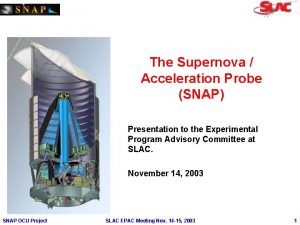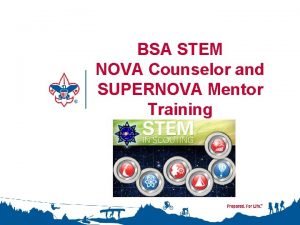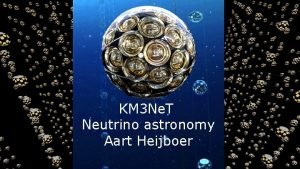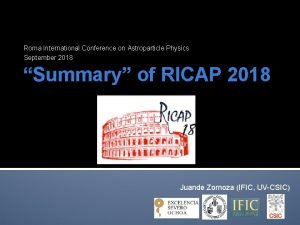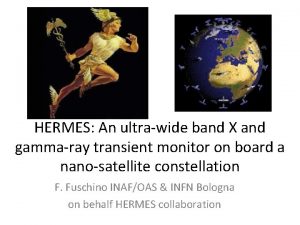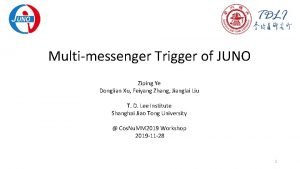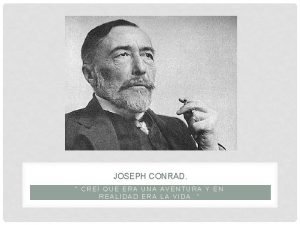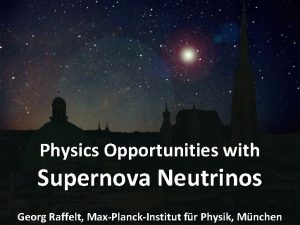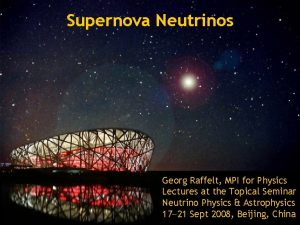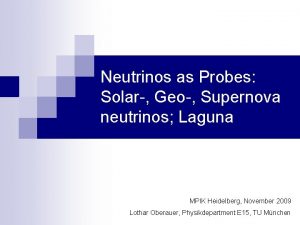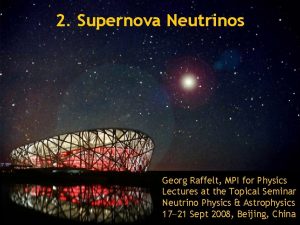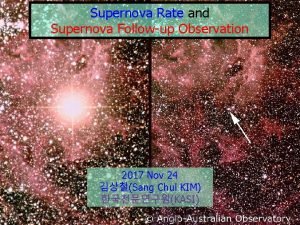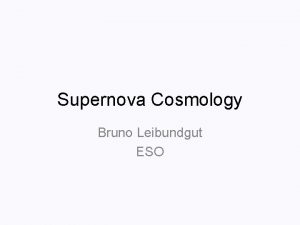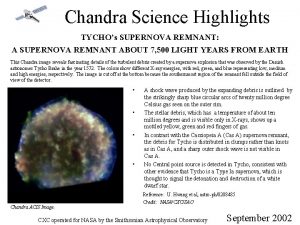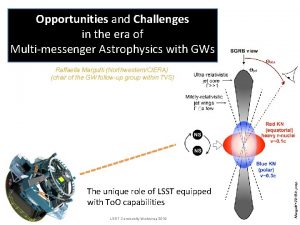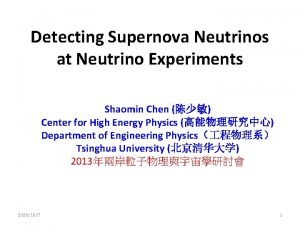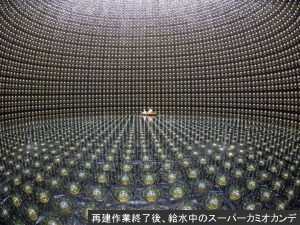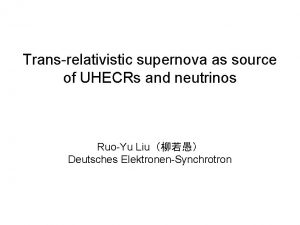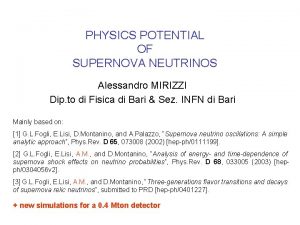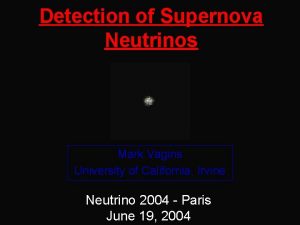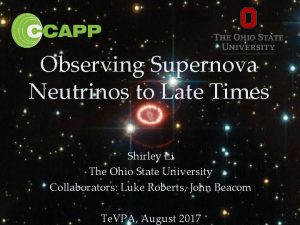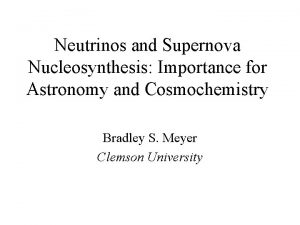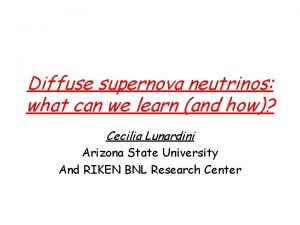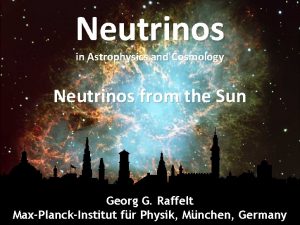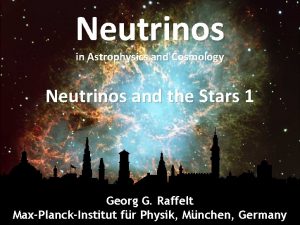Supernova Neutrinos in the MultiMessenger Era SNEWS 2






























- Slides: 30

Supernova Neutrinos in the Multi-Messenger Era, SNEWS 2. 0 June 15, 2019 Supernova Neutrino Detection M. Nakahata Kamioka Observatory ICRR/IPMU, Univ. of Tokyo 1 SN 1987 A 1

Contents n Introduction n What we have learned from SN 1987 A n What we want to learn in the next supernova n Supernova detectors in the world n History of detectors n Detector type n What kind of data are expected in each detector n Future large volume detectors for supernova I will concentrate on burst neutrino detection by usual interactions. CEv. NS detection will be presented by Rafael Lang this afternoon. Pre-supernova detection will be presented by Chinami Kato and Volodymyr Takhistov tomorrow, and presented by a poster by Koji Ishidoshiro yesterday. 2

SN 1987 A: supernova at LMC(50 kpc) Kamiokande-II IMB-3 Ohio state Morton mine, USA Kamioka mine, Japan ~5000 ton Fiducial 2140 ton fiducial Water Charenkov Water Cherenkov Total energy released by n e was measured to be ~5 x 1052 erg. BAKSAN Baksan tunnel, Russia 330 ton in 3150 tanks Liquid scintillator Observed events Kam-II (11 evts. ) IMB-3 (8 evts. ) Baksan (5 evts. ) 24 events total The measured energy was consistent with core-collapse scenario. Large error in neutrino mean energy. No detailed information of burst process was observed because of low statistics. 3

SN 1987 A: supernova at LMC(50 kpc) Kamiokande-II IMB-3 Ohio state Morton mine, USA Kamioka mine, Japan ~5000 ton Fiducial 2140 ton fiducial Water Charenkov Water Cherenkov Detection efficiency BAKSAN Baksan tunnel, Russia 330 ton in 3150 tanks Liquid scintillator Energy threshold (at 50% eff. ) ~8. 5 Me. V @ Kamiokande ~28 Me. V @ IMB ~10 Me. V @ Baksan 4

History of supernova detectors 1 9 8 0 1 9 8 1 1 9 8 2 1 9 8 3 1 9 8 4 1 9 8 5 1 9 8 6 1 9 8 7 1 9 8 8 1 9 8 9 1 9 9 0 1 9 9 1 1 9 9 2 1 9 9 3 1 9 9 4 1 9 9 5 1 9 9 6 1 9 9 7 1 9 9 8 1 9 9 9 2 0 0 0 2 0 0 1 2 0 0 2 2 0 0 3 2 0 0 4 2 0 0 5 2 0 0 6 2 0 0 7 2 0 0 8 2 0 0 9 2 0 1 0 2 0 1 1 2 0 1 2 2 0 1 3 2 0 1 4 2 0 1 5 2 0 1 6 2 0 1 7 2 0 1 8 2 0 1 9 BAKSAN (330 t liq. sci. ) IMB (7000 t water) Kamiokande (2140 t water) LSD(90 t liq. sci. ) SN 1987 a MACRO(560 t liq. sci. ) LVD (330 1000 t liq. sci. ) Super-Kamiokande (32000 t water) Amanda/Ice. Cube SNO (1000 t D 2 O) SNO+ Kam. LAND(1000 t liq. sci. ) Borexino(300 t liq. sci. ) HALO(76 t Pb, 3 He counter) Daya Bay(160 t liq. sci. ) NOv. A(14 kt liq. sci. ) 5

The Baksan underground scintillation telescope (Russia) Each detector Total number of standard detectors…………. . 3184 Total target mass…………. …. . . 330 tons of oil-based scintillator Lower horizontal layer ……………. …. . . 130 tons is used for supernova monitor ~30 n ep e+n events expected for 10 kpc SN. Running since 1980. Sensitive up to ~20 kpc. No candidate (except for SN 1987 A) for 33. 02 years’ observation time from June 1980 to December 2018. Upper limit of SN rate: < 7. 0 /century (90% C. L. ) (from V. Petkov, will be presented in TAUP 2019). 6

LVD detector (at Gran Sasso, Italy) LVD consists of an array of 840 counters, 1. 5 m 3 each. Total target: 1000 t liquid scintillator 4 Me. V threshold With <1 Me. V threshold for delayed signal (neutron tagging efficiency of 50 +- 10 %) E resolution: 13%(1 s) at 15 Me. V ~300 nep e+n events expected for 10 kpc SN. No candidate for 8577 days from 1992 to 2017. Upper limit of SN rate: < 0. 098 /yr (90% C. L. ) C. Vigorito et al. , ICRC 2017 From W. Flugione 7

Supernova burst detectors in the world now Liquid scintillator Water, Ice Other Borexino target mass Super-Kamiokande LVD Baksan SNO+ 0. 3 kt 1 kt 32 kt 1 kt Kam. LAND HALO Pb 76 t NOv. A surface 14 kt Micro. Boo. NE surface Ar 90 t Ice. Cube 1 kt Daya Bay 1 gt 0. 16 kt 8

Summary of supernova neutrino detectors Detector Type Location Mass (kton) Events @ 10 kpc Status Super-K Water Japan 32 8000 Running (SK V) LVD Scintillator Italy 1 300 Running Kam. LAND Scintillator Japan 1 300 Running Borexino Scintillator Italy 0. 3 100 Running Ice. Cube Long string South Pole (600) (106) Running Baksan Scintillator Russia 0. 33 50 Running Mini. Boo. NE Scintillator USA 0. 7 200 (Running) HALO Lead Canada 0. 079 20 Running Daya Bay Scintillator China 0. 33 100 Running NOn. A Scintillator USA 15 3000 Running SNO+ Scintillator Canada 1 300 (Running) Micro. Boo. NE Liquid argon USA 0. 17 17 Running DUNE Liquid argon USA 40 3000 Future Hyper-K Water Japan 540 110, 000 Future JUNO Scintillator China 20 6000 Future Ice. Cube Gen-2 Long string South pole (600) (106) Future plus reactor experiments, DM experiments. . . From K. Scholberg 9

Single volume liquid scintillator detectors Kam. LAND (Kamioka, Japan) Borexino (Gran Sasso, Italy) SNO+ (SNO Lab. , Canada) 300 ton liq. sci. Running since 2007. 1000 ton liq. sci. Running since 2002. 1000 ton liq. sci. Under construction. 10

Energy spectrum expected at the liquid scintillation detectors Expected energy spectrum (10 kpc) nx parameter measurement with np elastic scattering events (3000 t eqv. ) 1000 ton, Nakazato-model Phys. Rev. D 86, 125001 (2012) From K. Ishidoshiro np elastic scattering n ep e+n n-e scattering 2. 2 Me. V gamma NC gamma n e. C e+B ne. C e-N Expected number of events n ep e+n n+e- n+en+p 12 C CC for 1 kton, 10 kpc ~300 Determine luminosity and mean energy of nx (nx : nm , nt at the source) ~20 ~80 (>200 ke. V) 60 From K. Ishidoshiro 11

Ice. Cube (South pole) M. G. Aartsen et al 2017 JINST 12 P 03012 Ice. Cube detector • • Number of Optical modules: 5160 10 -inch PMTs in each optical module Number of strings: 86 Instrumented volume: 1 km 3 Supernova neutrinos coherently increase single rates of PMTs. A&A 535, A 109 12

High frequency signal variation by SASI=standing accretion shock instability luminosity 2 -D(axially symmetric) simulation with PROMETHEUS-VERTEX code Supernova at 10 kpc Ice. Cube “event” rate energy T. Lund et al. , Phys. Rev. D 82, 063007(2010). 13

Ice. Cube – Hit. Spooling and directional information Hit. Spool Interface (installed in 2013) Possible directional information in case of black hole formation Simulation of black hole formation Abrupt rate change A&A 535, A 109 The Hit. Spool Interface enables • Record all hit information in 90 sec data around the burst with full data stream. • Use correlation of hits of DOMs to estimate mean energy with a resolution of about 30% at 10 kpc. 2013 ICRC Proceeding by V. Baum ~40(several) deg. for 10 (5) kpc SN with smallest n mass Neutrino mass (e. V) B. Eberhardt's Ph. D. thesis 14

Super-K: Number of events vs. distance LMC Galactic Center 32 kton water Cherenkov M 31 Betelgeuse For each interaction Livermore simulation Nakazato et al. Ethr=3. 5 Me. V(kin) n ep e+n Nakazato 7300 3100 n+e- 320 170 16 O 110 57 CC Supernova at 10 kpc Directional information 32 kton SK volume 4. 5 Me. V(kin) threshold No oscillation case. T. Totani, K. Sato, H. E. Dalhed and J. R. Wilson, Ap. J. 496, 216(1998) Livermore simulation Nakazato et al. K. Nakazato, K. Sumiyoshi, H. Suzuki, T. Totani, H. Umeda, and S. Yamada, Ap. J. Suppl. 205 (2013) 2, (20 Msun, trev=200 msec, z=0. 02 case) 15

Sensitivity of Super-K for the model discrimination For 10 kpc supernova Time variation of event rate Time variation of mean energy High statistics enough to discriminate models Cooperation: H. Suzuki 16

Super-K: directional information Reconstructed direction (Simulation of a 10 kpc supernova) n e+p n+e Distance vs. pointing accuracy Livermore Model 3. 1 -3. 8 deg. for 10 kpc n+e n e+p Nakazato model 4. 3 -5. 9 deg. for 10 kpc 17

Gadolinium project at Super-K: SK-Gd Identify nep events by neutron tagging with Gadolinium. ne n p + e Gd γ 8 Me. V ΔT~30μs Vertices within 50 cm Captures on Gd Gadolinium has large neutron capture cross section and emit 8 Me. V gamma cascade. 0. 1% Gd gives 100% 80% ~90% efficiency for n capture In Super-K this means ~100 tons of water soluble Gd 2(SO 4)3 60% 0. 01% Gd gives 40% ~50% efficiency. Main physics target Observation of Supernova Relic Neutrinos. 20% 0% 0. 0001% 0. 1% 1% Gd in Water Plan to start 0. 01%Gd phase in early 2020. 18

In case of Galactic supernova Improve pointing accuracy (10 kpc SN simulation) n e w/o tagging n e+p n e tagged with 80% eff. n+e scattering If n e can be tagged and subtracted from the plot, directional events (n+e scattering events) can be enhanced and pointing accuracy can be improved. 19

SK-Gd: Pointing accuracy with neutron information Livermore Model Nakazato model Solid: with neutron anti-tag. Dash: without neutron anti-tag. Solid: with neutron tag. Dash: without neutron tag. 1. 9 -2. 5 deg. for 10 kpc with n anti-tag. (3. 1 -3. 8 deg. w/o that) 3. 3 -4. 1 deg. for 10 kpc with n anti-tag. (4. 3 -5. 9 deg. w/o that) Pointing accuracy can be improved by neutron anti-tagging. 20

Electromagnetic follow up Optical magnitude 地球 Earth SK-Gd can cover Nakamura, Horiuchi, Tanaka, Hayama, Takiwaki, Kotake, MNRAS 461 (3): 3296 -3313, http: //arxiv. org/abs/1602. 03028 21

Future Large Volume Detectors JUNO(China) (20 kton Liq. Sci. ) Precise measurement of average energy and luminosity for all neutrino flavors. ~1% for <E> for n e ~10% for <E> for ne ~5% for <E> for n. X DUNE/LBNF (US) (40 kton Liq. Ar) ne + 40 Ar e- + 40 K* is the dominant interaction. ~3000 ne events for 10 kpc SN. Hyper-Kamiokande (220 kton Water) 50 k~80 k n ep events for 10 kpc supernova. Precise measurement of time variation. 1~2 deg. pointing accuracy. Detection of supernova neutrinos at nearby galaxies. 22

JUNO: Expected signals Expected number of events for a SN @ 10 kpc 1) IBD events dominate at the high energy range 2) nu-p ES channel dominates at low energies 3) coincidence events vs. singles events 4) e. vs. p discrimination: Pulse shape discrimination Lu, YFL, Zhou, PRD 2016 23

JUNO: Sensitivity for each neutrino flavor n e average energy vs. Luminosity Precision of 1% in <E> n. X average energy vs. Luminosity ne average energy vs. Luminosity Precision of 10% in <E> Lu, YFL, Zhou, ar. Xiv: 1605. 07803 (Phys. Rev. D 94, 023006 (2016)) Plots are for no n oscillation. Precise measurement of average energy and luminosity for all neutrino flavors. Precision of 5% in <E> 24

DUNE: Expected time profile and spectrum Flavor composition as a function of time Energy spectra integrated over time For 40 kton @ 10 kpc, Garching model (no oscillations) From K. Scholberg 25

DUNE: effect of neutrino oscillations Note that the neutronization burst gets substantially suppressed with flavor transitions Simple MSW assumption (assume OK at early times) NMO: IMO: From K. Scholberg 26

Hyper-K: high statistics measurement Time variation due to Standing Accretion Shock Instability(SASI) Tomborra et al. , 2013 Time variation due to fast rotation Pointing accuracy Livermore Model Nakazato model Takiwaki, 2015 Quite high rate to study fine time structure 1~2 deg. accuracy for 10 kpc SN. 6~15 deg. even for LMC (50 kpc). 8. 2 5. 8 5. 7 at 50 kpc 19 15 14 at 50 kpc 27

Supernova rate in nearby galaxies Cumulative rate (yr-1) in 2000 -2011 Ando, Beacom, Yuksel, Phys. Rev. Lett. 95, 171101 (2005) Estimated supernova rate within 10 Mpc ~14 SNe/20 y Horiuchi, Beacom, Bothwell, and Thompson, J. 769 (2013) 113 Estimated supernova rate: “ 15 CCSNe”: ~50 SNe/20 y “ 11 CCSNe”: ~36 SNe/20 y UV obs. : ~18 SNe/20 y 28

Hyper-K: supernova neutrino from nearby galaxies Detection probability at Hyper-K Dotted: I. H. Dashed: N. H. Solid: No osc. Horiuchi, Beacom, Bothwell, and Thompson, J. 769 (2013) 113 Supernova rate based on observed supernovae from 2000 to 2011 (w/ and w/o SN 2008 S-like dim supernova), and expectation from UV observation. Expected Number of SNe 10~14 SNe/20 years (15 CCSNe) 5~ 8 SNe/20 years (11 CCSNe) 2~ 3 SNe/20 years (ROT-UV) Conditions: Ø Livermore simulation Ø At least one event with 10 Me. V threshold Ø # range for no osc. , N. H. and I. H. Ø Not include M 31, i. e. <1 Mpc are not included 29

Conclusions • Many detectors in the world are waiting for next supernova. • Large number of neutrino events are expected at various detectors. • Various interaction modes are detected in liquid scintillation detectors. • Study of fine time structure by Ice. Cube. • Good pointing accuracy by Super-K and will be improved by SK-Gd. • Future large volume detectors will give detailed information. • Precise energy measurement of all neutrino types by JUNO. • ne measurement by DUNE. • 1~2 deg. level pointing accuracy and nearby galaxy SN by Hyker-K. 30
 Snews
Snews Neutrinos
Neutrinos Neutrinos
Neutrinos Neutrinos
Neutrinos Supernova
Supernova Supernova spectra
Supernova spectra Bruno leibundgut
Bruno leibundgut Supernova
Supernova Supernova acceleration probe
Supernova acceleration probe Supernova mentor
Supernova mentor Vodafone multimessenger
Vodafone multimessenger Multimessenger
Multimessenger Light curve
Light curve Multimessenger
Multimessenger Multimessenger
Multimessenger Multimessenger
Multimessenger Kilonova
Kilonova Victorian era vs elizabethan era
Victorian era vs elizabethan era Creí que era una aventura y en realidad era la vida
Creí que era una aventura y en realidad era la vida Vi uma estrela tão alta
Vi uma estrela tão alta Quiz 2 the baroque era
Quiz 2 the baroque era Chó sói
Chó sói Thiếu nhi thế giới liên hoan
Thiếu nhi thế giới liên hoan điện thế nghỉ
điện thế nghỉ Một số thể thơ truyền thống
Một số thể thơ truyền thống Thế nào là hệ số cao nhất
Thế nào là hệ số cao nhất Trời xanh đây là của chúng ta thể thơ
Trời xanh đây là của chúng ta thể thơ Ng-html
Ng-html Số nguyên tố là gì
Số nguyên tố là gì đặc điểm cơ thể của người tối cổ
đặc điểm cơ thể của người tối cổ Tia chieu sa te
Tia chieu sa te
